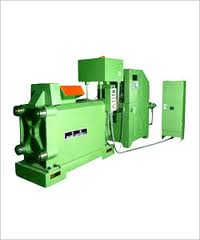Difference between revisions of "Cold Briquetters"
Jump to navigation
Jump to search
(Created page with "Category:Particle Formation{{Knoppen}} <noinclude><!------------------------------------------------ * READ THIS FIRST * Only edit this page if you can improve the content. ...") |
PurplePen19 (talk | contribs) |
||
| Line 7: | Line 7: | ||
* Please start editing this page after the /noinclude | * Please start editing this page after the /noinclude | ||
* -------------------------------------------------></noinclude> | * -------------------------------------------------></noinclude> | ||
[[File:Cold Briquetters_1.jpg|thumb|200px|right|Cold Briquetters]] | |||
'''Cold Briquetters''' are [[Briquetters]] used in cold or lower temperature processes in industries. For cold briquetting at feed material temperatures of up to 100°C it may be necessary to add binders to improve briquette forming characteristics. In this way, coal fines have been briquetted for more than 100 years now. Binders are primarily used for the briquetting of substances that have inadequate adhesive forces and are thus unable to produce a firm briquette. | |||
==Common Features== | |||
*Typical briquette sizes range between 1.5 and 250 ccm. | |||
*Briquettes may be egg-, cushion- or rod-shaped. | |||
*Briquette characteristics are governed by the respective application and process requirements. | |||
Latest revision as of 05:05, 5 October 2012
Cold Briquetters are Briquetters used in cold or lower temperature processes in industries. For cold briquetting at feed material temperatures of up to 100°C it may be necessary to add binders to improve briquette forming characteristics. In this way, coal fines have been briquetted for more than 100 years now. Binders are primarily used for the briquetting of substances that have inadequate adhesive forces and are thus unable to produce a firm briquette.
Common Features
- Typical briquette sizes range between 1.5 and 250 ccm.
- Briquettes may be egg-, cushion- or rod-shaped.
- Briquette characteristics are governed by the respective application and process requirements.
